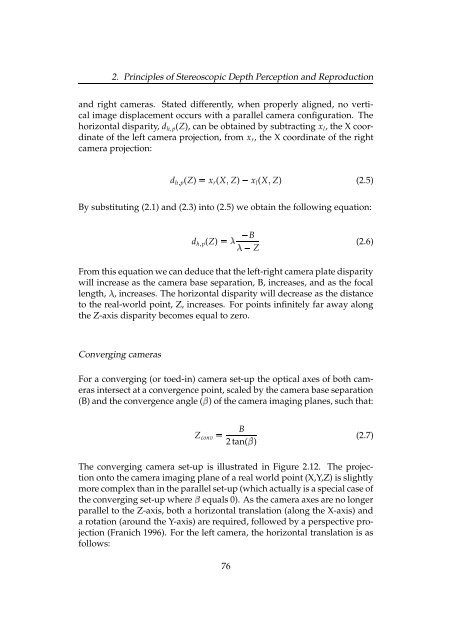Chapter 2 Principles of Stereoscopic Depth Perception and ...
Chapter 2 Principles of Stereoscopic Depth Perception and ...
Chapter 2 Principles of Stereoscopic Depth Perception and ...
Create successful ePaper yourself
Turn your PDF publications into a flip-book with our unique Google optimized e-Paper software.
d h p(Z) ¢<br />
Z conv ¢<br />
¤<br />
¤<br />
2. <strong>Principles</strong> <strong>of</strong> <strong>Stereoscopic</strong> <strong>Depth</strong> <strong>Perception</strong> <strong>and</strong> Reproduction<br />
<strong>and</strong> right cameras. Stated differently, when properly aligned, no vertical<br />
image displacement occurs with a parallel camera configuration. The<br />
horizontal disparity, d h p(Z), can be obtained by subtracting x l , the X coordinate<br />
<strong>of</strong> the left camera projection, from x r , the X coordinate <strong>of</strong> the right<br />
camera projection:<br />
d h p(Z) ¢ x r (X¡ Z) ¤ x l (X¡ Z) (2.5)<br />
By substituting (2.1) <strong>and</strong> (2.3) into (2.5) we obtain the following equation:<br />
B<br />
Z<br />
(2.6)<br />
From this equation we can deduce that the left-right camera plate disparity<br />
will increase as the camera base separation, B, increases, <strong>and</strong> as the focal<br />
length, , increases. The horizontal disparity will decrease as the distance<br />
to the real-world point, Z, increases. For points infinitely far away along<br />
the Z-axis disparity becomes equal to zero.<br />
Converging cameras<br />
For a converging (or toed-in) camera set-up the optical axes <strong>of</strong> both cameras<br />
intersect at a convergence point, scaled by the camera base separation<br />
(B) <strong>and</strong> the convergence angle ( ¡ ) <strong>of</strong> the camera imaging planes, such that:<br />
B<br />
2 tan( ¡ )<br />
(2.7)<br />
The converging camera set-up is illustrated in Figure 2.12. The projection<br />
onto the camera imaging plane <strong>of</strong> a real world point (X,Y,Z) is slightly<br />
more complex than in the parallel set-up (which actually is a special case <strong>of</strong><br />
the converging set-up where equals 0). As the camera axes are no longer<br />
parallel to the Z-axis, both a horizontal translation (along the X-axis) <strong>and</strong><br />
¡<br />
a rotation (around the Y-axis) are required, followed by a perspective projection<br />
(Franich 1996). For the left camera, the horizontal translation is as<br />
follows:<br />
76


